Did you know that road salt can reduce your garage floor’s lifespan by up to 30% during winter months? As winter descends, your garage floor faces a triple threat: road salt, melted snow, and fluctuating moisture. Overlooking key cleaning methods can quickly lead to unsightly salt stains, costly salt damage, and even the need for early repairs or resurfacing. This comprehensive guide arms you with startling facts, practical advice, and common mistakes to avoid – all so your garage floor remains spotless and safe even during the harshest winter days.
Startling Facts About Garage Floor Cleaning in Winter
If you think sweeping up a little salt and slush is enough, think again. Road salt doesn't just leave a white residue; it actively seeps into the floor surface, breaking down coatings and accelerating wear on even the most durable polyaspartic garage floor or epoxy floor. When melted snow and ice settle in, they carry harmful chemicals that eat away at both bare concrete and coated surfaces, leaving stubborn salt stains and weakened areas where water can freeze and expand. Garage floor cleaning in winter is not just for appearance – it's a proactive defense against expensive repairs.
Many homeowners are surprised to learn that skipping even a week of cleaning can result in salt damage that's almost impossible to reverse. Left unchecked, calcium chloride and road salt will pit and discolor surfaces, especially on older garage floors with worn coatings or visible floor clutter. The end result? Your expensive polyaspartic garage or epoxy coating may lose its shine and integrity before the season ends. Prioritizing cleaning at this time of the year isn't an option – it's essential if you want your floor coating to look great spring after spring.
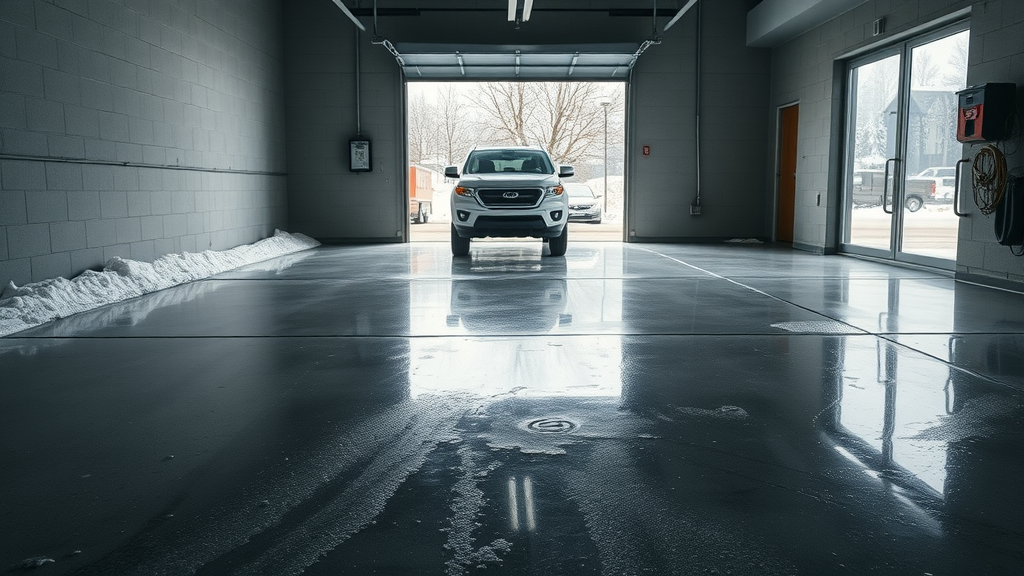
"Did you know that road salt can reduce your garage floor's lifespan by up to 30% during winter months?"
What You'll Learn About Garage Floor Cleaning in Winter
- The impact of winter elements like road salt on garage floors
- Key mistakes to avoid when cleaning garage floors in winter
- Best practices for effective garage floor cleaning in winter
- How to choose cleaning solutions and tools for your garage floor
- Differences between epoxy, polyaspartic, and other floor coatings
Understanding Winter’s Impact on Your Garage Floor
Winter is especially tough on garage floors because melted snow, de-icing agents, and freezing temperatures create a punishing cycle. Road salt, calcium chloride, and grit are tracked in by vehicles, where they sit atop or seep into the floor coating. This not only wears down protective layers but can accelerate chemical reactions that degrade both bare concrete and modern concrete coatings.
The ravages of winter affect every type of surface differently. While polyaspartic and epoxy coatings offer significant protection, they aren’t invincible. Tiny scratches and imperfections can allow moisture and salt to settle into the surface, creating salt stains and undermining adhesion. Over time, crystallized salt can create expansion, cracking, and pooled water that refreezes—major contributors to damage. Understanding the science of winter’s impact puts you ahead of problems before they start.
How Road Salt and Moisture Affect Garage Floor Coating
When cars enter the garage with snow and ice packed around their tires and undercarriage, they bring in more than just water. Road salt (sodium chloride and calcium chloride) is tough to remove and can be devastating to both epoxy coatings and polyaspartic coatings. As moisture evaporates, a residue of salt crystals is left. These chemically interact with water molecules and your garage floor’s surface, corroding, dulling, and etching both coatings and bare concrete.
Prolonged exposure to road salt introduces a constant wet-dry cycle. Salt-laden puddles may seem harmless but, as they dry, salt crystals become abrasive and seep into cracks and coatings. Without regular cleaning, you risk the dreaded “white haze” of salt stains that are notoriously tough to remove, sometimes even with commercial cleaners. When your floor coating looks great, it’s typically thanks to consistent removal of these substances before they do lasting harm.
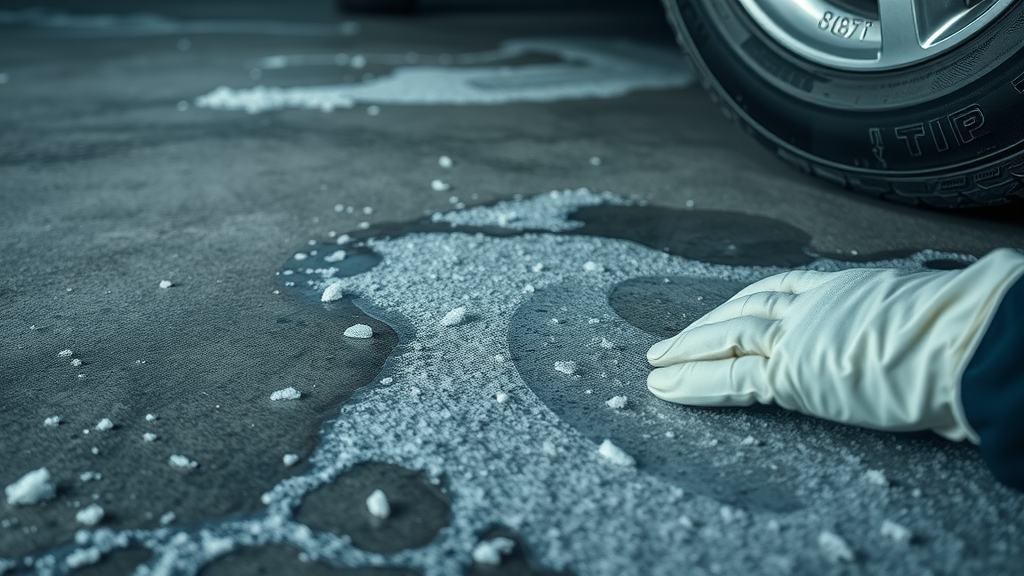
The Role of Polyaspartic and Epoxy Floor Coatings in Winter
Modern polyaspartic floor coatings and high-quality epoxy coatings are designed to withstand moisture and chemical intrusion better than plain concrete. Polyaspartic garage floors, in particular, offer faster curing, superior resistance to salt and chemical spills, and better performance in fluctuating temperatures. Still, even the most advanced coatings need regular care to fend off winter threats.
One key advantage of a polyaspartic floor coating is its increased flexibility and bond to concrete, making it less likely to crack when exposed to extreme temperature shifts. Epoxy, while tough, can sometimes yellow or weaken with salt exposure if not well maintained. In all cases, a consistent winter cleaning routine is your best defense to ensure your investment in garage floor coatings is protected against the season’s harshest conditions.
Common Mistakes in Garage Floor Cleaning in Winter
Even the best intentions can backfire when garage floor cleaning in winter isn’t done correctly. Many homeowners inadvertently speed up salt damage or degrade their expensive floor coatings with a few common errors. Awareness of these pitfalls is your first step toward a spotless, long-lasting garage floor.
Let’s break down these frequent mistakes so you can avoid them:
- Ignoring road salt buildup on garage floors – Postponing removal lets chemicals etch coatings, create tough salt stains, and accelerate wear.
- Using the wrong cleaning solutions for garage floor coatings – Not all products are safe for polyaspartic or epoxy; harsh chemicals can cloud or peel the finish.
- Hosing down your garage floor in freezing temperatures – Instead of cleaning, you risk forming sheets of ice, making the hazard even worse than before.
- Neglecting garage floor mats that can trap moisture and contaminants – Dirty mats won’t protect your floor and can become breeding grounds for more damage.
- Failing to dry the garage floor properly after cleaning – A wet vac or squeegee is your best friend; lingering moisture enables salt and mold to thrive.
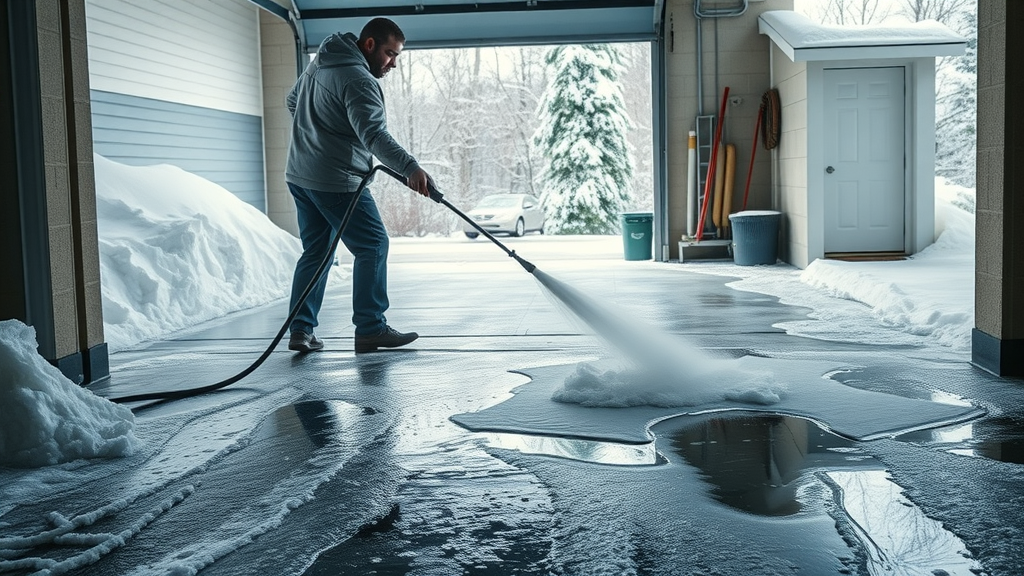
Step-By-Step Guide to Garage Floor Cleaning in Winter
Proper garage floor cleaning in winter is all about the right process, products, and patience. Whether you have a newly coated polyaspartic garage floor, classic epoxy floor, or just bare concrete, following this step-by-step method will keep salt stains and damage at bay—even in the heart of the coldest season.
Preparing Your Garage Floor: Tools and Products
Successful cleaning starts with preparation. Gather modern cleaning tools—like a stiff-bristled broom, soft mop, wet vac, non-abrasive scrub pads—and invest in high-quality yet coating-safe cleaning solutions specifically designed for garage floors. Avoid generic household detergents, as they may contain caustic chemicals or leave a film that reduces slip resistance. Winter cleaning also means keeping a snow shovel or brush handy to remove floor clutter and prevent the buildup of melted snow near the entrance.
If you’re working with a polyaspartic garage or epoxy system, double check that your cleaner is compatible. Many brands now offer coatings-friendly products that effectively dissolve road salt and calcium chloride without harming the finish. Store plenty of absorbent garage floor mats for the entry area and invest in floor squeegees to speed drying—essential for ensuring your floor is dry before traffic resumes.
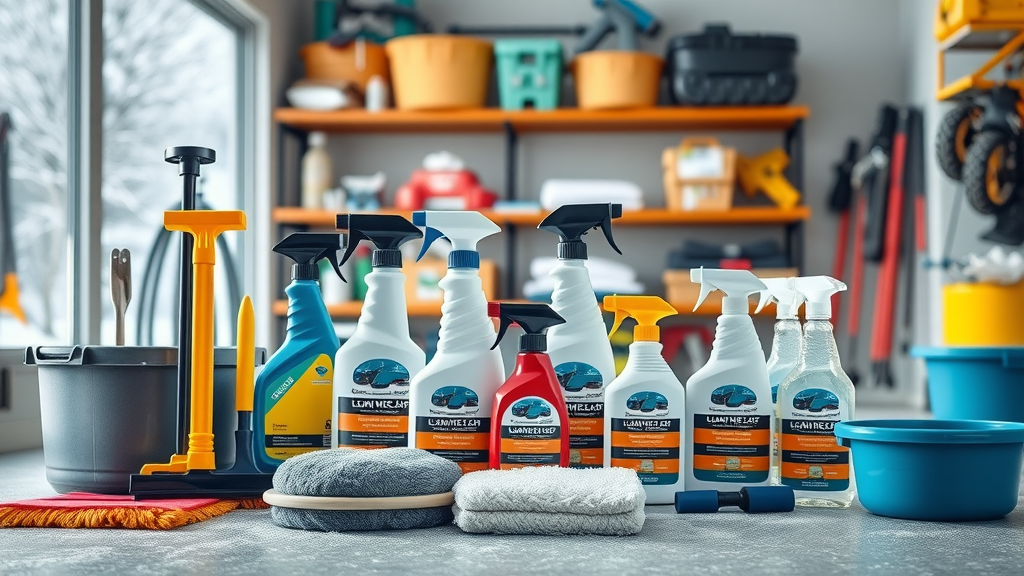
Cleaning Polyaspartic, Epoxy, and Other Floor Coatings
Begin by sweeping away loose debris and dry salt residue. For polyaspartic floor coatings and epoxy coatings, mix a PH-neutral cleaner with warm water and use a soft mop to gently scrub the floor surface, paying special attention to high-traffic or visibly stained areas. For tougher salt stains, let the solution sit for a few minutes before scrubbing in gentle, circular motions. After cleaning, use a wet vac or squeegee to remove any remaining solution, ensuring the floor is dry to prevent slip hazards and further chemical reaction.
For bare concrete, you can use a slightly stronger cleaner but avoid anything overly acidic. Regardless of your floor type, don’t forget to ventilate the space—you want to avoid residual fumes and help speed the drying process. Remember, routine gentle cleaning is far more effective than scrubbing hard once damage has set in. Your polyaspartic coating will repay you with an extended lifespan and a flawless, resilient finish.
Proper Use of Garage Floor Mats in Winter
Garage floor mats are among the most effective ways to trap melted snow, salt, and icy puddles before they reach sensitive floor coatings. Place heavy-duty mats at the garage threshold and under vehicles; these will act as barriers to contaminants, but only if maintained. Shake out, rinse, or vacuum mats at least once a week to prevent moisture and salt buildup beneath, which can otherwise transfer damage back to the underlying garage floor.
In high-traffic areas or workshops, consider using longer roll-out floor mats or modular tiles for full surface coverage. Not only do they simplify cleaning—just remove and rinse—but they also provide a buffer that can reduce slips and protect both epoxy and polyaspartic coatings from direct impact. For best results, invest in mats engineered for snow and ice, featuring raised edges to contain water and debris for easy disposal.
| Type | Resistance to Road Salt | Moisture Resistance | Recommended Cleaning Routine | Best Winter Accessories |
|---|---|---|---|---|
| Epoxy Floor | Moderate | Good | PH-neutral cleaner weekly, prompt salt removal | Rubber mats, wet vac |
| Polyaspartic Floor | Excellent | Excellent | Gentle scrubbing, salt-safe cleaners, weekly maintenance | Snow-catching mats, squeegee |
| Bare Concrete | Poor | Poor | Strong cleaner biweekly, seal if possible | Entire floor mat coverage |
| Floor Mats Only | Depends on mat | High if cleaned often | Shake out and rinse frequently | Raised-edge, absorbent mats |
Expert Strategies for Preventing Winter Damage to Garage Floors
The best cleaning routines are proactive—not reactive. A truly resilient garage floor requires a layered strategy in winter, combining regular salt removal with the right products and accessories. Here’s how experts stay ahead of winter’s worst:
- Regular removal of road salt and ice
- Using suitable de-icing materials safe for your garage floor coating
- Setting up a drying area with garage floor mats
- Scheduling professional floor coating maintenance
Catching salt leaks and puddles right away—especially around tires and doorways—prevents stubborn salt stains and keeps your garage living space healthy for the whole family. When in doubt, book a free design consultation or maintenance check to make sure your floor is protected and your cleaning methods are up to date.
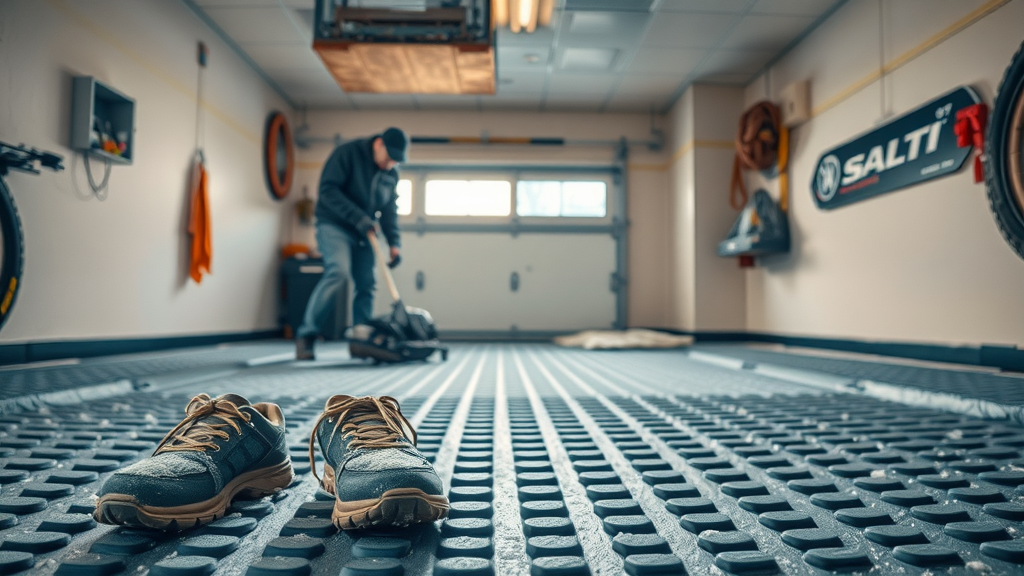
"A quality polyaspartic garage floor can withstand winter challenges, but only with the right maintenance and cleaning routine."
People Also Ask: Garage Floor Cleaning in Winter
How do I keep my garage floor clean in the winter?
Keeping your garage floor clean in the winter means removing road salt, melted snow, and grit daily if possible. Use a broom or wet vac to address messes as soon as they’re spotted, followed by mopping with a PH-neutral cleaning solution compatible with your floor type. Place absorbent garage floor mats at entrances and under cars, and regularly shake out or rinse these mats to prevent salt buildup. Most importantly, never let standing water or salt residue linger—it’s a primary cause of salt stains and floor coating breakdown.
Best Garage Floor Cleaning Practices for Winter
Consistency is key. Perform quick sweeps each day and plan a deeper clean at least once a week during the snowy season. For coated garage floors, stick to recommended cleaning products to avoid harm. In especially harsh climates, consider sealing or recoating older floors before winter sets in. Sharing this post with friends and neighbors spreads smart habits—and helps everyone avoid the headaches of salt damage come spring.
How to dry out a garage floor in winter?
Drying is critical after each cleaning session. For best results, use large fans or leave the garage door slightly ajar during milder winter moments to encourage air circulation. Wet vacuums excel at extracting water from floor surfaces and mats. For persistent dampness, spread old towels or absorbent mats, then replace them as they become saturated. Avoid heaters or devices that create too-rapid drying; they can stress coatings and cause cracking.
Effective Drying Methods for Garage Floors in Winter Conditions
After removing water, go over the surface with a squeegee, working toward the garage entrance. Ensure all mats are lifted, dried, and aired out away from freezing temperatures. The goal is to keep the floor is dry—reducing the risk of slips, salt reaction, and freeze-thaw damage. Maintain a drying schedule after snowstorms or whenever significant melted snow is tracked in.
What is the best thing to clean a garage floor with?
The ideal cleaning solution depends on your floor type. For polyaspartic and epoxy, choose a PH-neutral, non-abrasive floor cleaner. These remove dirt and salt residue without dulling or hazing the protective finish. For bare concrete, use a stronger degreaser, but always rinse thoroughly. Avoid bleach, acid-based products, or any cleaner not labelled floor coating-safe.
Recommended Cleaning Solutions for Garage Floor Coatings
Try brand-specific solutions recommended for your particular floor coating (e.g., ArmorPoxy, Rust-Oleum). In a pinch, a mild dish soap and warm water mixture is gentle enough for daily upkeep. Always run a spot test in an inconspicuous area before using a new product on high-end polyaspartic floor or epoxy coatings.
Can you hose down your garage floor?
Hosing down the garage floor seems quick and easy—but in winter, it’s a major risk. Water can freeze quickly, especially near the entrance, leading to dangerous slips or even ice that damages floor coatings. If you must rinse, use a wet vac to extract water immediately and only on warmer days when freezing isn’t a danger.
Risks and Considerations for Hosing Down Garage Floors in Winter
Running water over your garage floor in sub-freezing temperatures may solve one issue (cleaning) while creating another (ice). Stick to spot cleaning, mopping, and targeted use of damp—not wet—methods for winter maintenance. If a deeper wash is absolutely necessary, plan it during a midwinter thaw and dry thoroughly using fans and absorbent mats.
Frequently Asked Questions About Garage Floor Cleaning in Winter
-
How often should I clean my garage floor in winter?
For best protection, sweep daily and deep clean weekly, or more often if you see heavy salt residue or melted snow after storms. -
Is it safe to use commercial cleaners on polyaspartic garage floors?
Only if the product is labeled safe for polyaspartic or epoxy coatings. Always test in a small area first and rinse thoroughly. -
Should I reapply floor coating before winter?
If your existing coating is several years old or shows wear, a new coat can offer stronger protection against salt damage and winter hazards.
Key Takeaways: Garage Floor Cleaning in Winter
- Regular cleaning is essential to prevent damage from road salt and moisture.
- Choose products compatible with your floor coating type.
- Proper drying and use of garage floor mats mitigate winter risks.
Conclusion: Protect Your Garage Floor This Winter
Final Thoughts on Garage Floor Cleaning in Winter
Winter’s hidden threats don’t have to spell disaster for your garage floors—a smart cleaning strategy keeps them shining year after year.

Call Us Now to Get Your FREE Quote! 800-280-9210
To enhance your understanding of effective garage floor maintenance during winter, consider exploring the following resources:
-
“7 Ways to Keep Your Garage Clean During Winter”: This article offers practical tips, including the use of waterproof mats and proper cleaning solutions, to maintain a clean and safe garage environment throughout the colder months. (utahgaragedoors.net)
-
“How to Maintain Your Garage Floors in the Winter”: This guide provides insights into the impact of winter elements on garage floors and offers strategies for regular maintenance to prevent damage from road salts and moisture. (wetreadwell.com)
By incorporating these expert recommendations, you can effectively protect your garage floor from winter-related damage and ensure its longevity.
 Add Row
Add Row  Add
Add 

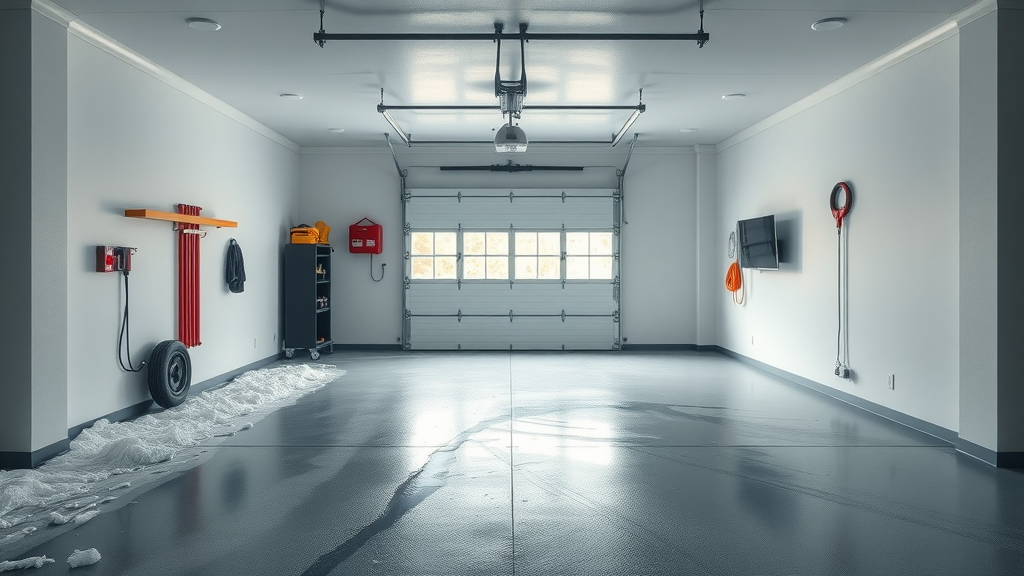
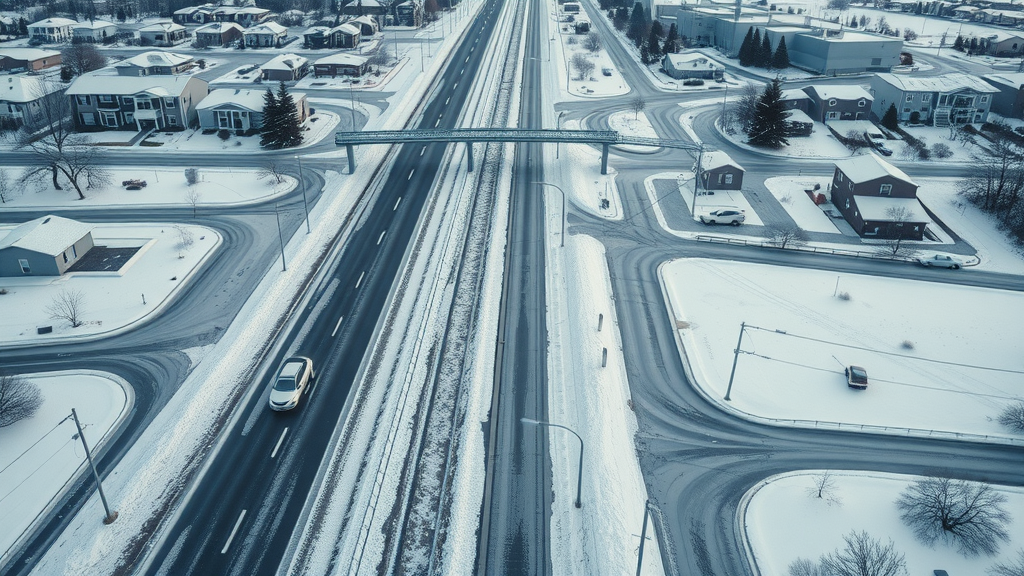
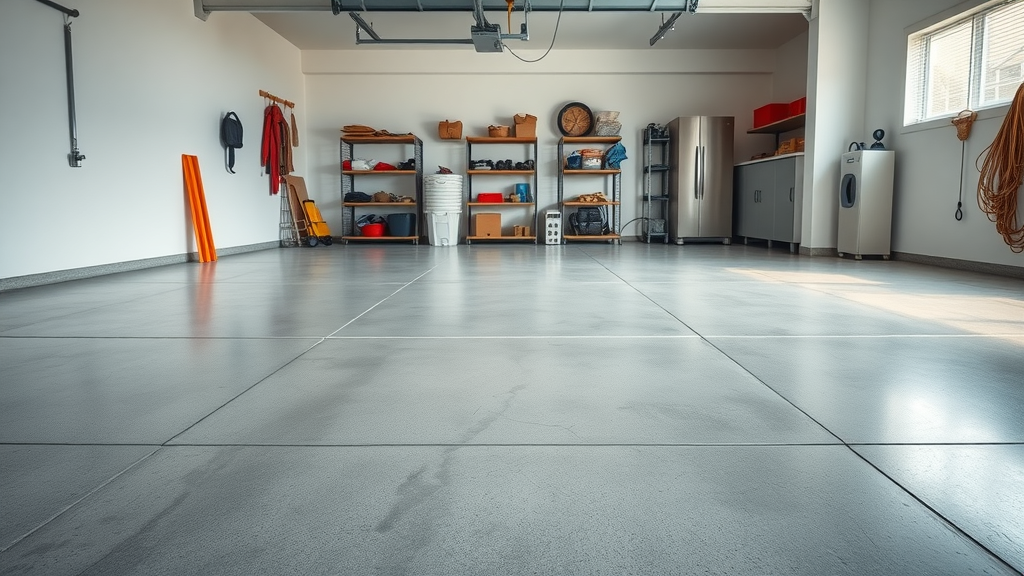
Write A Comment